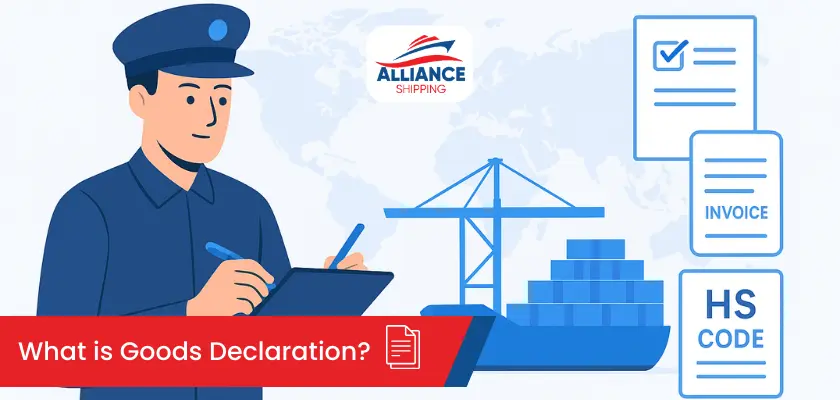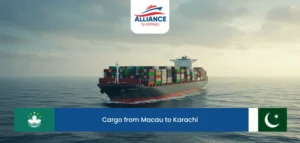Goods Declaration, a full form of GD in shipping industry, is a document that provides information on goods that are imported or exported in the shipment. This piece of information is issued specifically for the customs department. It acts as a formal statement for customs authorities, which allows them to evaluate appropriate duties, taxes, and double-check compliance with regulations.
But what is included in a goods declaration document, and why is it necessary? To find out, continue reading this article prepared by Alliance Shipping, so you are familiar with the core documentation when shipping internationally.
What Makes a Goods Declaration?
Goods Declaration seems to be a document that only states the list of goods that are being imported or exported to and from any country. But what completes a goods declaration is the following key information:
Identification Details
- Exporter and Importer Information – Names, addresses, and contact details
- Consignor and Consignee
- Customs Broker or Agent (if used)
Transport Information
- Mode of Transport – Air, sea, road, or rail
- Transport Document Reference – Bill of lading, airway bill, or CMR number
- Port or Place of Loading and Unloading
Goods Description
- Precise Description – Must be clear and specific
- Quantity – In appropriate units (kg, liters, units)
- Weight – Gross and net weight
- Packaging Details – Type and number of packages
- Marks and Numbers – Any identifying marks on packaging
Classification & Valuation
- HS Code (Harmonized System Code) – For tariff classification
- Customs Value – Transaction value, cost, insurance, and freight (CIF) or other valuation
- Currency – Currency of the declared value
Country of Origin: Where the goods were manufactured or produced
Taxes & Duties
- Applicable Tariffs – Customs duty rate based on HS code
- Other Charges – VAT, excise, anti-dumping duties if applicable
- Total Amount Payable – Calculated by customs or declared by importer
Compliance & Control Details
- Import/Export Licenses – If required for controlled goods
- Certificates – Such as phytosanitary, health, or conformity certificates
Goods Declaration Statement
A signed statement by the importer or customs broker certifying the accuracy of the information and compliance with laws.
Signature, date, and place of declaration.
What is the Role of Goods Declaration in Shipments Today
A goods declaration serves as the official statement to customs authorities about goods/cargo being imported or exported across the borders, and this is a key role for customs. It guarantees a transparent, lawful, and properly taxed trade shipment, while helping governments maintain safety, security, and trade regulations.
We’ve prepared a list of key roles of goods declaration in shipments today:
- Facilitates customs clearance by providing all required shipment details.
- Determines applicable duties and taxes based on value and classification.
- Supports compliance with trade regulations and security measures.
- Prevents smuggling and fraud through accurate disclosure of goods.
- Acts as legal proof of shipment contents and value in case of disputes.
What are the Types of Goods Declaration?
There are 3 main types of goods declaration in shipping.
Import Declaration
A document specifically for providing information on goods/cargo that is brought into a country. It tells customs what the goods are, how much they are worth, and where they come from. This helps the government check if the goods are allowed, and it also makes sure the right taxes and duties are paid.
Export Declaration
A specific document that is essential for declaring goods/cargo sent out of a country to another place. It gives details about the items, the buyer, and the country they are heading to. Customs uses this to keep track of exports, control restricted goods, and collect trade information.
Transit Declaration
A declaration required to allow goods to pass through one country en route to another is called a transit declaration. The goods just move across the transit countries. A transit declaration ensures the goods are only passing through and that they remain under customs control.
Step-by-Step Filing Process
Step 1: Collect all required documents such as commercial invoice, packing list, bill of lading/airway bill, certificates (if needed), and permits. Double check all details like description, quantity, HS code, and value, and verify they are correct and match across documents.
Step 2: Submit the GD to customs either on paper (traditional method) or electronically through systems like WeBOC (Pakistan), TradeNet (Singapore), or similar platforms. Electronic filing is usually faster and more accurate, but keep a backup copy.
Step 3: File the GD before the shipment arrives (for imports) or before it leaves the country (for exports). Meeting deadlines helps avoid delays, storage costs, or penalties.
Common Mistakes and How to Avoid Them
- HS Code Errors
Many traders use the wrong HS code for their goods, which leads to incorrect duty or tax calculation. To avoid this, always check the official tariff schedule or get help from a customs broker.
- Wrong Valuation
Sometimes the value of goods is declared too high or too low, either by mistake or misunderstanding. This causes problems with duties and taxes. To prevent this, use the correct invoice value and include all necessary costs like freight and insurance.
- Missing Certificates
Some products need special certificates (like health, safety, or origin certificates). Missing them can delay clearance. Always confirm the required documents before shipping.
- Mismatched Data Across Documents
If the details on invoices, packing lists, or bills of lading don’t match the declaration, customs may suspect fraud. Double-check that all documents have consistent and accurate information.
Consequences of Incorrect or Missing GD
In some cases, a goods declaration might not be significant, but if it is needed and you have an incorrect or missing goods declaration, here is how you will suffer:
- Customs delays.
- Fines and penalties.
- Goods seizure.
- Legal action.
GD by Learn Logistics with Alliance Shipping
Goods Declaration (GD) is a highly crucial process in global trade, which makes it smooth to transport goods across country borders at the same time, but without compromising on legal and regulatory compliance. Not only is a correct and complete GD useful to actually help traders to escape delays in customs and associated financial penalties and potential confiscation of goods, but it is also useful in promoting fair trade as well as proper collection of taxes.
Electronic systems and automated checkups in customs have boosted the speed and especially the transparency and error-free filing. But that also implies that traders should be knowledgeable about the evolving regulations and online solutions. Stay connected with Learn Logistics with Alliance Shipping, so you can get more information about the necessary documents for shipping.























